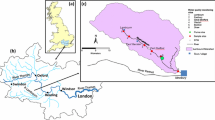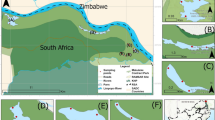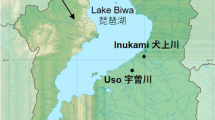Abstract
Nitrogen and phosphorus are the primary nutrients that affect water quality in streams in the midwestern USA and high concentrations of these nutrients tend to increase algal biomass. However, how nutrients interact with physical controls in regulating algal biomass is not well known in agricultural streams. Eighteen streams in east-central Illinois (USA) were sampled during June and September 2003 to analyze factors possibly regulating algal biomass. Additionally, two shaded and two non-shaded sites in the Embarras River in east-central Illinois were sampled intensively from June to December 2003. Both sestonic and periphytic chlorophyll-a (chl-a) were analyzed, and periphytic chl-a was assessed on natural substrata and unglazed ceramic tiles. Although high concentrations of nutrients were found in these streams (mean total P = 0.09–0.122 mg l−1 and mean NO3-N=4.4–8.4 mg l−1), concentrations of sestonic chl-a were low among all sites and both sampling periods (<18 mg m−3, median values of 5 and 3 in June and September, respectively). Filamentous algae were an important component of the algal communities in streams with stable substrata. Periphytic chl-a was generally not related to the concentration of N or P in the water column, and in non-shaded streams periphyton appeared at times to be light-limited due to turbid water. Turbidity was found to be an important factor controlling chl-a on ceramic tiles across the 18 sites and for the Embarras River sites; chl-a decreased exponentially in concentration (132–0 mg m−2) as turbidity increased from 4 to 39 NTU (r 2 = 0.80). In general, the interaction between hydrology and light (turbidity) likely controlled algal biomass in these nutrient-rich, agricultural streams.
Similar content being viewed by others
References
APHA, 1998. Standard Methods for the Examination of Water and Wastewater, (20th edn). American Public Health Administration, Washington, DC
Biggs B. J. F. (1995). The contribution of flood disturbance, catchment geology and land use to the habitat template of periphyton in stream ecosystems. Freshwater Biology 33: 419–438
Biggs B. J. F. (2000). Eutrophication of streams and rivers: dissolved nutrient–chlorophyll relationships for benthic algae. Journal of the North American Benthological Society 19: 17–31
Biggs B. J. F. and Close M. E. (1989). Periphyton biomass dynamics in gravel bed rivers: the relative effects of flow and nutrients. Freshwater Biology 22: 209–231
Bothwell M. L. (1988). Growth rate responses of lotic periphytic diatoms to experimental phosphorus enrichment: the influence of temperature and light. Canadian Journal of Fisheries and Aquatic Sciences 45: 261–270
Bushong S. J. and Bachmann R. W. (1989). In situ nutrient enrichment experiments with periphyton in agricultural streams. Hydrobiologia 178: 1–10
Cattaneo A. and Amireault M. C. (1992). How artificial are substrata for periphyton?. Journal of the North American Benthological Society 11: 244–256
David M. B. and Gentry L. E. (2000). Anthropogenic inputs of nitrogen and phosphorus and riverine export for Illinois, USA. Journal of Environmental Quality 29: 494–508
David M. B., Kovacic D. A., Gentry L. E. and Smith K. M. (1997). Nitrogen balance in and export from an agricultural watershed. Journal of Environmental Quality 26: 1038–1048
Dodds W. K., Jones J. R. and Welch E. B. (1998). Suggested classification of stream trophic state: distributions of temperate stream types by chlorophyll, total nitrogen, and phosphorus. Water Research 32: 1455–1462
Fausey N. R., Brown L. C., Belcher H. W. and Kanwar R. S. (1995). Drainage and water quality in Great Lakes cornbelt states. Journal of Irrigation and Drainage Engineering 121: 283–288
Grimm N. B. and Fisher S. G. (1986). Nitrogen limitation in a Sonoran Desert stream. Journal of the North American Benthological Society 5: 2–15
Hill W. R. (1996). Effects of light. In: Stevenson, R. J., Bothwell, M. L. and Lowe, R. L. (eds) Algal Ecology: Freshwater Benthic Ecosystems, pp 121–148. Academic Press, San Diego, California
Hill W. R. and Dimick S. M. (2002). Effects of riparian leaf dynamics on periphyton photosynthesis and light utilization efficiency. Freshwater Biology 47: 1245–1256
Hill W. R., Ryon M. G. and Schilling E. M. (1995). Light limitation in a stream ecosystem: responses by primary producers and consumers. Ecology 76: 1297–1309
Lohman K., Jones J. R. and Perkins B. D. (1992). Effects of nutrient enrichment and flood frequency on periphyton biomass in northern Ozark streams. Canadian Journal of Fisheries and Aquatic Sciences 49: 1198–1205
Lowe R. L., Golladay S. W. and Webster J. R. (1986). Periphyton response to nutrient manipulation in streams draining clearcut and forested watersheds. Journal of the North American Benthological Society 5: 221–229
Marker A. F. H., Nusch E. A., Rai H. and Riemann B. (1980). The measurement of photosynthetic pigments in freshwaters and standardization of methods: conclusions and recommendations. Archiv Fur Hydrobiologie Beiheft Ergebnisse Limnologie 14: 91–106
McIsaac G. F. and Hu X. (2004). Net N input and riverine N export from Illinois agricultural watersheds with and without extensive tile drainage. Biogeochemistry 70: 251–271
Moore J. W. (1977). Some factors effecting algal densities in a eutrophic farmland stream. Oecologia 29: 257–267
Munn M. D., Osborne L. L. and Wiley M. J. (1989). Factors influencing periphyton growth in agricultural streams of Central Illinois. Hydrobiologia 174: 89–97
Rhoads B. L. and Herricks E. E. (1996). Naturalization of headwater streams in Illinois: challenges and possibilities. In: Brookes, A. and Shields, F. D. (eds) River Channel Restoration: Guiding Principles for Sustainable Projects, pp 331–367. John Wiley and Sons, New York
Rosemond A. D. (1993). Interactions among irradiance, nutrients and herbivores constrain a stream algal community. Oecologia 94: 585–594
SAS Institute, 1990. SAS/STAT User’s Guide, Version 6, 4th edn. SAS Institute, Cary, North Carolina
Schaller J. L., Royer T. V., David M. B. and Tank J. L. (2004). Denitrification associated with plants and sediments in an agricultural stream. Journal of the North American Benthological Society 23: 667–676
Steinman A. D. and Lamberti G. A. (1996). Biomass and pigments of benthic algae. In: Hauer, F. R. and Lamberti, G. A. (eds) Methods in Stream Ecology, pp 295–313. Academic Press, San Diego, California
Swanson C. D. and Bachmann R. W. (1976). A model of algal exports in some Iowa streams. Ecology 57: 1076–1080
Jones J. R. (1996). Phosphorus–chlorophyll relationship in temperate streams and its variation with stream catchment area. Canadian Journal of Fisheries and Aquatic Sciences 53: 99–105
Welch E. B., Jacoby J. M., Horner R. R. and Seeley M. R. (1988). Nuisance biomass levels of periphytic algae in streams. Hydrobiologia 157: 162–168
Wiley M. J., Osborne L. L. and Larimore R. W. (1990). Longitudinal structure of an agricultural prairie river system and its relationship to current stream ecosystem theory. Canadian Journal of Fisheries and Aquatic Sciences 47: 373–383
Zar J. H. (1999). Biostatistical Analysis. Prentice Hall, Upper Saddle River, New Jersey
Author information
Authors and Affiliations
Corresponding author
Rights and permissions
About this article
Cite this article
Figueroa-Nieves, D., Royer, T.V. & David, M.B. Controls on chlorophyll-a in nutrient-rich agricultural streams in Illinois, USA. Hydrobiologia 568, 287–298 (2006). https://doi.org/10.1007/s10750-006-0114-3
Received:
Accepted:
Published:
Issue Date:
DOI: https://doi.org/10.1007/s10750-006-0114-3




